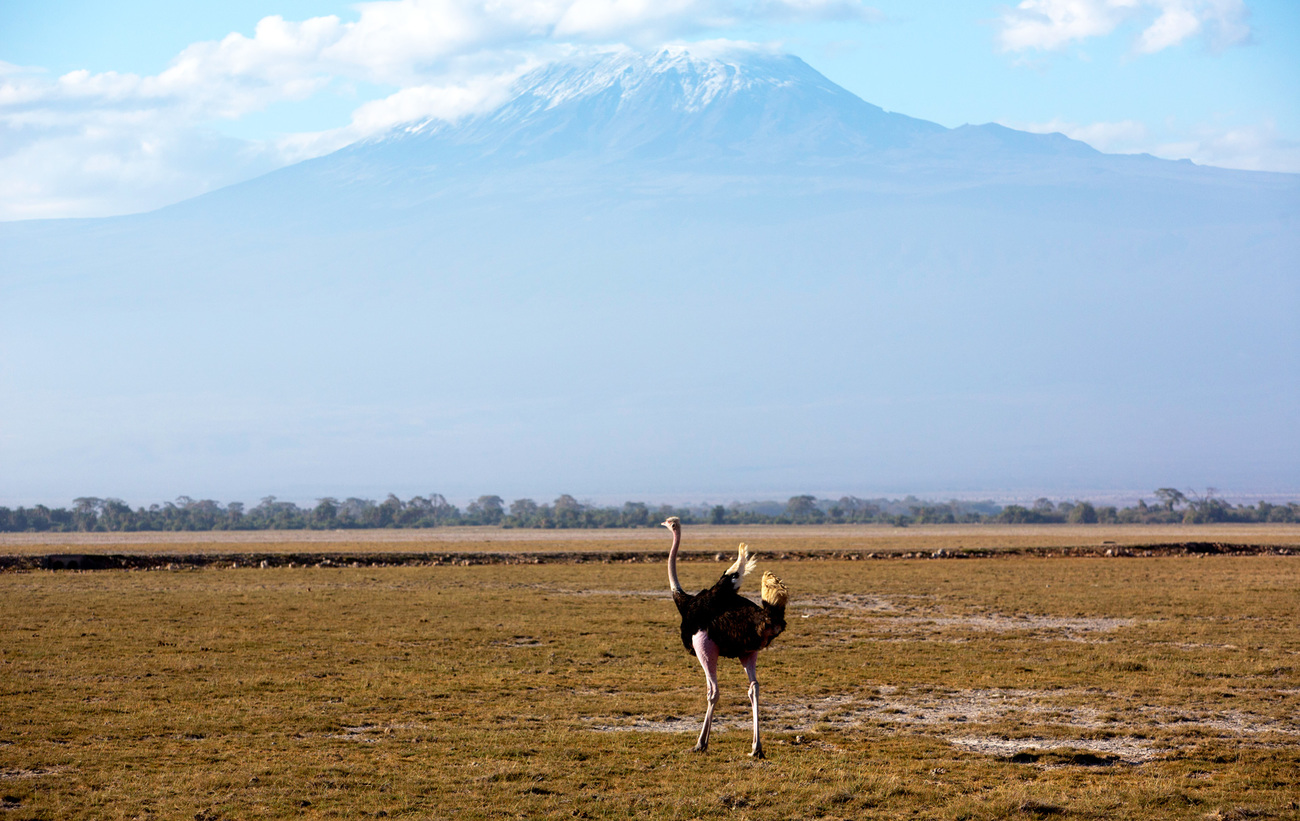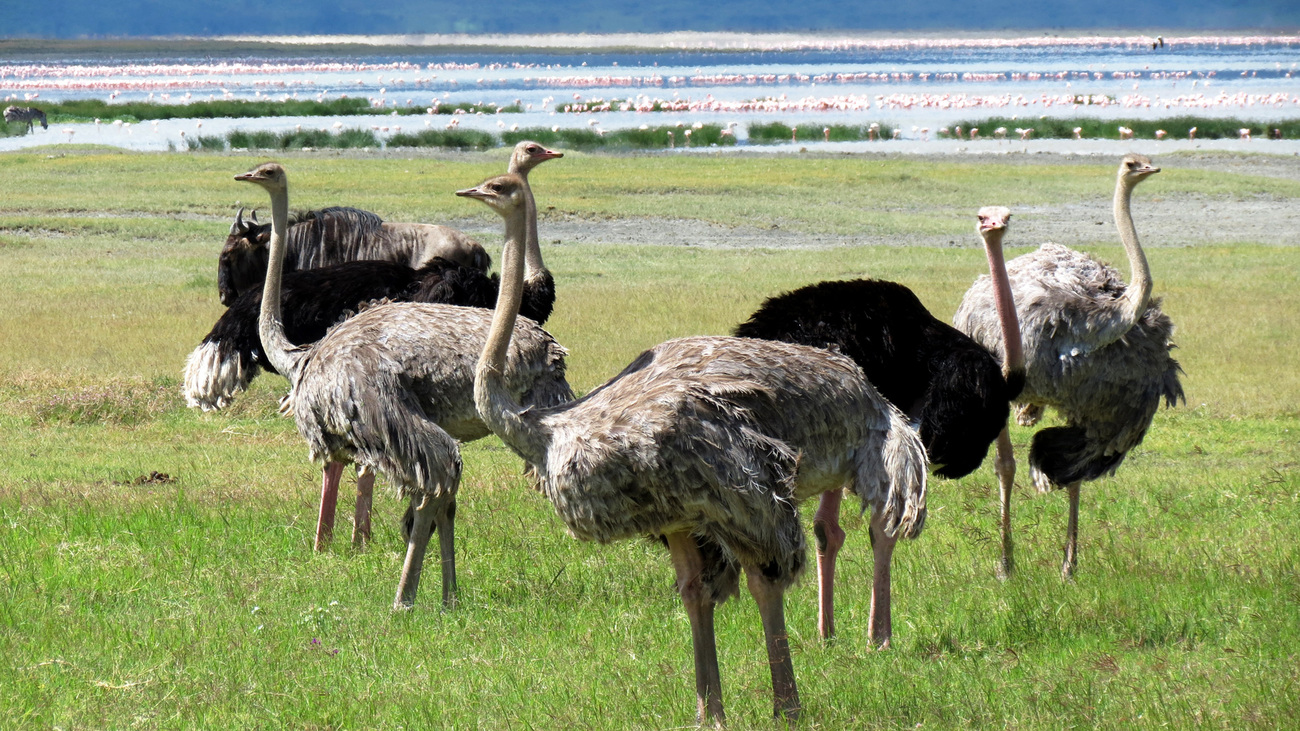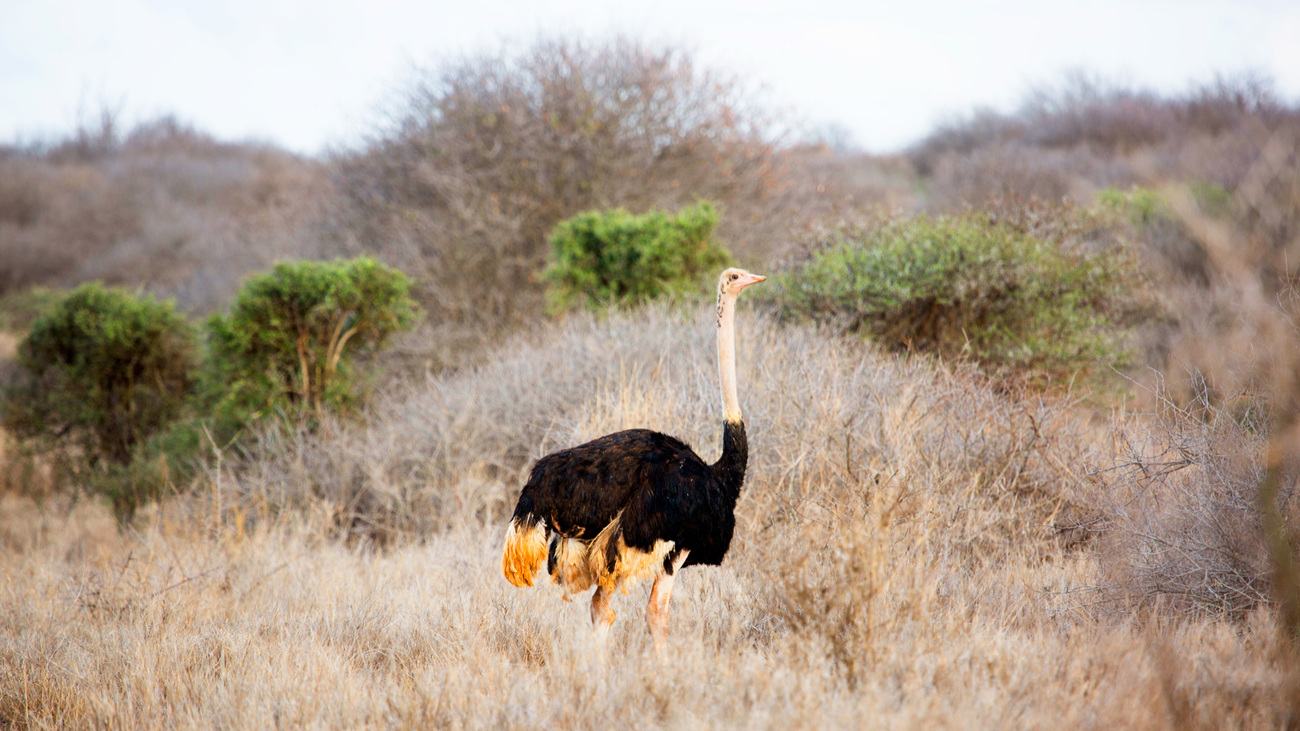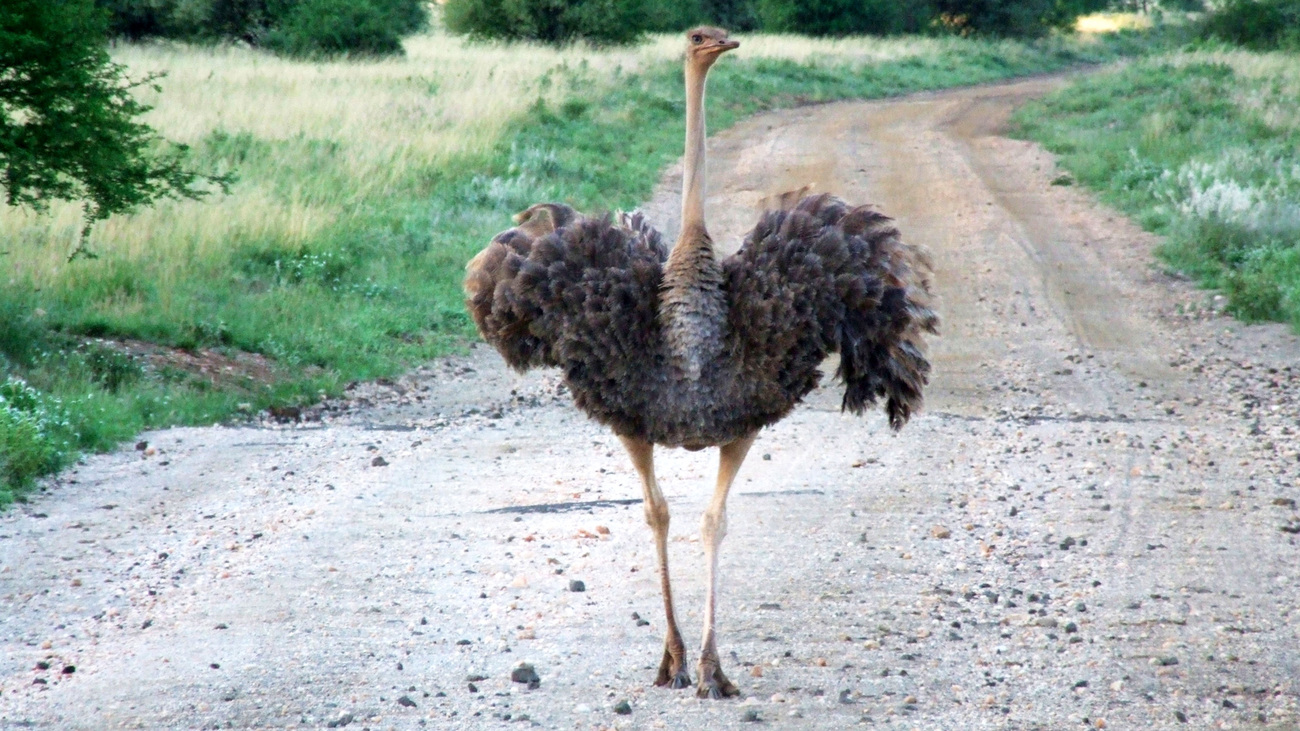Ostriches
Ostriches are the largest, heaviest, and fastest-running birds in the world. In fact, they’re the fastest of all two-legged animals. When they need to sprint, they can reach speeds of up to 69 kilometers per hour (43 miles per hour), and when they need to defend themselves, they can kick with enough power to kill a lion.
Ostriches look quite different from most other birds. They have long, strong legs, a large body, a long neck, and a small head. They also have the largest eyes of any bird—they are 5 centimeters (2 inches) wide. These eyes are actually bigger than their brains, which are unusually small for their body size. This trait is common among all ratites, the biggest family of flightless birds.
There are two living species of ostriches—the common ostrich and the Somali ostrich. The common ostrich is native to sub-Saharan Africa, while the Somali ostrich resides in the Horn of Africa region.
The ostrich lives in a variety of habitats, from hot savannahs to deserts to open woodlands. They can be found in pairs, small groups, or large collections, depending on the season. For breeding, small groups are run by a male leader with a dominant female. The male mates with multiple hens in the group and digs a shallow nest for the entire group to use. When all the eggs are laid, the male leader and dominant female incubate them for around 42 days before they hatch. Ostrich chicks hatch fully feathered and ready to run.
Ostriches help keep their ecosystems healthy by controlling rodent populations and spreading the seeds of the many plants they eat. They also form symbiotic relationships with other animals in the ecosystem. For example, ostriches allow gazelle to share their feeding grounds, and in return, the highly responsive gazelles provide an early warning of incoming predators.
What is an ostrich’s scientific name?
The common ostrich’s scientific name is Struthio camelus. The name originates from the Ancient Greek strouthokamilos, which means ‘camel-sparrow’. They used the term for ‘camel’ in reference to the ostrich’s dry habitat in Africa.
The Somali ostrich’s scientific name is Struthio molybdophanes.
Are ostriches endangered?
The common ostrich is listed as least concern on the IUCN Red List, meaning it’s not endangered or considered close to becoming endangered in the near future. However, the IUCN notes that the ostrich’s population trend is decreasing, and they face a number of threats such as hunting, habitat loss, and natural predators.
The Somali ostrich is listed as vulnerable. This species is threatened by hunting, including for practice, and habitat loss.
Where do ostriches live?
Ostriches are native to Africa and aren’t naturally found anywhere else in the world. The common ostrich lives predominantly in two areas—across the southern portion of the Sahara desert, covering Mauritania, Mali, Niger, Chad, Sudan, and down into Tanzania, and in the south of the continent covering Namibia, Zimbabwe, Botswana, and South Africa. The Somali ostrich lives in the Horn of Africa, including in Ethiopia, Kenya, Somalia, and Djibouti. Their habitats include hot savannahs and open woodland.
There is also a small population of ostriches living in Australia. Humans brought these birds to Australia in the 1890s and again in the 1970s because they wanted to farm their feathers and meat. However, most of the farms failed, and the birds were released into the wild, where they survived and still exist in small numbers. However, it’s thought that breeding is difficult for the ostriches in the Australian climate, so they may not be able to survive long-term.
Threats
Although ostriches aren’t endangered, they do face a range of threats. They’re hunted for their feathers, meat, and eggs, and they are caught for use in tourist entertainment. They’re also experiencing habitat loss and face many natural predators.

Hunting and illegal poaching
While legal ostrich farms exist all over the world, wild ostriches are also poached in their natural habitat. Their feathers are used in fashion, their meat and eggs for food, and their fat in skincare products.
Human entertainment
In some parts of Africa, ostriches have been trained for saddle and sulky racing, and tourists can ride ostriches as an activity. These birds are illegally poached from the wild in the same manner as those hunted for meat and feathers, and they live short, painful lives, as the racing and weight-carrying wear down their bodies.
Habitat loss
As farms, towns, tourist spots, infrastructure, and plantations develop and expand throughout Africa, they decrease the amount of land available for ostriches. This lowers their population numbers over time, since fewer resources are available and cannot sustain a larger number of ostriches.
Natural predators
Natural predators are, of course, a natural part of life. However, ostriches and their eggs have a large number of predators, including lions, leopards, cheetahs, wild dogs, hyenas, vultures, and jackals. When ostrich populations decrease, these high rates of predation hinder their ability to recover.
FAQs
What do ostriches eat?
Ostriches are omnivores and eat a variety of foods, depending on what’s available to them. They get most of their water from eating plants, and they also eat lizards, snakes, rodents, and insects.
Can ostriches fly?
Ostriches cannot fly. They, along with other flightless birds like emus, cassowaries, kiwis, and rheas, lack the strong, anchored pectoral muscles required to lift their bodies off the ground.
How fast can an ostrich run?
When an ostrich is scared or in danger, it can sprint at up to 69 kilometers per hour (43 miles per hour) for a short amount of time. When they’re running over a long distance, they typically maintain speeds of around 50 kilometers per hour (31 miles per hour). Their long, powerful legs can cover as much as 4.8 meters (16 feet) in a single stride.
How tall is an ostrich?
Including their long necks and heads, ostriches can reach heights of up to 2.75 meters (9 feet). Female ostriches are typically shorter than males.

How much does an ostrich weigh?
An ostrich weighs 90 to 136 kilograms (200 to 300 pounds). Ostriches are the heaviest bird in the world.
Is an ostrich a bird?
Though they use their wings to keep their balance while running rather than to fly, ostriches are birds. They are the biggest and heaviest birds in the world. Flying isn’t the main condition that makes a bird a bird. Instead, birds need to have wings, feathers, two legs, warm blood, and egg-laying habits. Hollow bones and the ability to fly are optional features.
Is an ostrich a mammal?
Ostriches aren’t mammals, they’re birds. Though they don’t fly, they do lay eggs.
How often do ostriches lay eggs?
Unlike chickens, who lay eggs all year round, ostriches only lay eggs during a specific period (typically starting in June and ending in October or early November). Ostriches breed as a group run by a dominant male and female. The male digs a shallow nest for the entire group and mates with multiple hens, including the dominant female. When all the eggs are laid, the dominant male and female incubate them for around 42 days.
How many eggs does an ostrich lay?
The number of eggs a female ostrich lays depends on her role in the herd. The dominant female, who only mates with the dominant male, can lay up to 11 eggs. Her eggs receive the safest location in the nest while they incubate. The other hens, who either also mated with the dominant male or with one of the other males, lay two to six eggs.
How big is an ostrich egg?
At 15 centimeters (5.9 inches) long and weighing 1.5 kilograms (3.1 pounds), ostrich eggs are the biggest eggs in the world. However, they are actually the smallest eggs relative to the size of the adult bird. They’re also edible, just like other bird eggs, and ostrich farms do exist to supply restaurants and supermarkets with eggs for cooking.
Can you ride an ostrich?
Though it is possible to ride an ostrich, the practice is unsafe for humans and animals. Ostriches are large and strong enough to carry a human, and the activity is available to tourists in some parts of Africa. However, ostriches don’t carry any weight on their backs in the wild, so their bodies are damaged by these uncomfortable and painful practices. As ostriches can become violent when under stress or threat, this also makes ostrich riding potentially dangerous for humans.
Are ostriches dangerous?
Thanks to their strong legs, ostriches can reach immense speeds and deliver dangerous kicks when they feel threatened. Like most wildlife in Africa, it’s essential to keep a safe distance and not provoke them.

How long do ostriches live?
In the wild, ostriches typically live from 30 to 40 years. They can live in captivity for up to 50 years.
Do ostriches bury their heads in the sand?
The phrase ‘to bury one’s head in the sand’ means to ignore unpleasant realities. It comes from the belief that ostriches stick their heads in the sand to hide from predators, even though it only stops the ostriches from seeing the predators, not the other way around.
However, this behavior is actually a myth. Ostriches don’t try to hide from predators by burying their heads. Animal behaviors typically only persist when they help the species survive, even if the benefit isn’t always immediately apparent. If any ostrich ever stuck its head in the sand when it saw a predator coming, it would not survive, and the behavior would not be passed along.
There are a few theories about where the belief came from. Firstly, ostriches build their nests in the ground and will sometimes stick their heads into the nest to tend to their eggs. It’s possible that people misunderstood the reason for this. Another possibility stems from defensive behavior. Because ostriches are so large and distinctively shaped, they can be seen by predators from very far away. To try and minimize their visibility, they sometimes lower their bodies to the ground. From afar, it could look as if they’d stuck their heads in the ground.
What is a baby ostrich called?
Like many other species of birds, an ostrich’s baby is known as a chick or a hatchling.
Can ostriches swim?
Ostriches have been caught swimming on camera before, both in the wild and in zoos. Not a lot is known about why they swim or how often it happens. It could just be an easy way to cool down on hot days.
What is the difference between an emu and an ostrich?
Emus and ostriches are both flightless birds of a similar size and appearance, and they’re members of the same family. They have quite a lot in common, from their small brain-to-body ratio to their long legs and slender necks. However, it is fairly easy to tell them apart.
While emus are the biggest birds in Australia, ostriches are the biggest birds in the world and are significantly larger. Ostriches are about 1.25 meters taller and 105 kilograms heavier than emus.
You can also tell emus and ostriches apart by looking at their feet. Emus have three toes and ostriches only have two. Feather colors can be another giveaway—male ostriches have black feathers with white-tipped wings and tails, and females have dark brown feathers. Emus, on the other hand, are consistently dark-colored all over.
Emus and ostriches also live in different places. Emus are native to Australia, while ostriches are native to Africa. The ancestors of the two birds lived together on the supercontinent Gondwana around 90 million years ago and evolved into different species once the continent split into separate land masses.
What sound does an ostrich make?
Ostriches communicate with each other through sounds and can produce a wide variety of growls, hisses, chirps, and honks. Males also have a special breeding call called a booming call. They fill a special sac in their throat with air and make a low, muffled roar that can alert females to their presence even when they’re very far away.
Do ostriches have teeth?
Ostriches do not have teeth. Like many other birds, they have a two-part stomach that helps them digest their food. The first part uses enzymes to begin breaking up food, and the second part, called the gizzard or muscular stomach, breaks up food by force. Ostriches swallow grit like small stones or sand, which collects in their gizzard and assists in pulverizing the food, so they can get by without teeth.
What does an ostrich look like?
Ostriches are birds—but they don’t look much like the ones seen outside your bedroom window. They’re tall animals with two long legs, a large, oval-shaped body, and a small head on the end of a long neck. They can’t fly, but they’re the fastest two-legged animals in the world.
How can you help?
Ostriches are victims of poaching and face increasing habitat loss. Learn more about IFAW’s landscape conservation work and how we combat wildlife crime.
